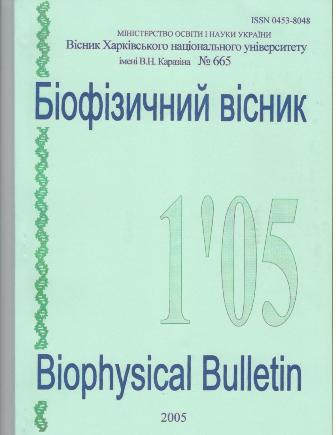Спектроскопічне дослідження взаємодії іонів Си2+ із ДНК
Анотація
Отримані ІЧ-спектри поглинання розчинів тимусної ДНК Н20 і D2O з різним вмістом іонів міді [Си2+]/[Р]=0,05÷0,8 ([Na+] = 0,15 M). Істотне збільшення інтенсивності смуг у ділянці поглинання сахаро-фосфатного остова, що спостерігається при відношенні [Cu2+]/[P]=0,4 ÷0,6, вказує на взаємодію іонів міді з фосфатними групами ДНК. Досить тонкий інтервал концентрацій міді, у якому спостерігається збільшення поглинання, свідчить на користь конформаційного переходу, що у ряді робіт іменується компактизаціей ДНК. Подальше збільшення вмісту іонів міді в розчині веде до денатурації молекули ДНК, що супроводжується спадом інтенсивності смуг поглинання цукрофосфатного кістяка та гіперхромізмом в області коливань азотистих основ. Отримані методом УФ-спектроскопії криві плавлення ДНК дозволяють зробити висновок, що при [Cu2+]/[P]=0,05÷0,1 у розчині з силою 0,15 М іони міді не мають істотного впливу на такі параметри переходу спіраль-- клубок як температура переходу, інтервал переходу та величина гіперхромного ефекту. Проте вже за [Cu2+]/[P] =0,2 температура плавлення ДНК знижується, а інтервал плавлення поширюється.
Завантаження
Посилання
2. Корнилова С.В., Капинос Л.Е., Томкова А. и др. // Биофизика. 1994. Т.39. Вып.З. С.423-436
3. Sissoeff J., Grisvaldt J., Cuile E. // Progr. Biophis. and Mol. Biol. 1976. V.31. №2. P.165-199
4. Корнилова С.В., Сорокин В.А., Благой Ю.П., Ванеев В.А., Арутюнян С.Г. // Мол. биология. 1991. Т.25. Вып.З. С.648-657
5. Hackl E., Kornilova S., Kapinos L et. al. // J. Mol. Struct. 1997. V.408/409. P.229-232
6. Hackl E., Kornilova S., Blagoi Yu. // Metal ions in biology and medicine. 1998. V.5. P.74-79
7. Е.В. Хакл, С.В. Корнилова, Ю.П. Благой II Біофізичний вісник. 1998. №1. С.62-70
8. Kornilova S., Hackl E., Kapinos L., et. al. // Acta Biochim. Polon. 1998. V.45. Mel. P.107-117
9. Getashvili G.R., Gerasimov V.V., Zaalishvili M.M. // Stud. Biophys. 1976. V.60. P.83-88.
10.Корнилова С. В., Ясем П., Григорьев Д.Н. и др. // Биофизика. 1998. Т.43. Вып.1. С.46-52.
11.Благой Ю.П., Сорокин В.А., Валеев В.А. и др. // Молекулярная биология. 1978. Т. 12. Вып.4. С.795-805
12.Коваль Ю.В., Благой Ю.П., Товстяк В.В. // Біофізичний вісник. 2003. Вип. 1(12). №1. С.40-43
13. Muller W., Crothers D.M., // Eur. J. Biochem. 1975. V.54. P.267-277
14. Fishman E. // Appl. Opt. 1962. №1. 493
15.Бабушкин А.А., Бажулин П.А.. Королев Ф.В. и др. Методы спектрального анализа. М.: МГУ, 1962.- 273с.
16. Taillandier E., Liquier J. // Methods in enzimol. 1990. V.211. P.307-335
17. Малеев В.Я., Семенов М.А. // Биофизика. 1971. Т.16. Вып.З. С.389-397
Автори, які публікуються у цьому журналі, погоджуються з наступними умовами:
- Автори залишають за собою право на авторство своєї роботи та передають журналу право першої публікації цієї роботи на умовах ліцензії Creative Commons Attribution License, котра дозволяє іншим особам вільно розповсюджувати опубліковану роботу з обов'язковим посиланням на авторів оригінальної роботи та першу публікацію роботи у цьому журналі.
- Автори мають право укладати самостійні додаткові угоди щодо неексклюзивного розповсюдження роботи у тому вигляді, в якому вона була опублікована цим журналом (наприклад, розміщувати роботу в електронному сховищі установи або публікувати у складі монографії), за умови збереження посилання на першу публікацію роботи у цьому журналі.
- Політика журналу дозволяє і заохочує розміщення авторами в мережі Інтернет (наприклад, у сховищах установ або на особистих веб-сайтах) рукопису роботи, як до подання цього рукопису до редакції, так і під час його редакційного опрацювання, оскільки це сприяє виникненню продуктивної наукової дискусії та позитивно позначається на оперативності та динаміці цитування опублікованої роботи (див. The Effect of Open Access).





